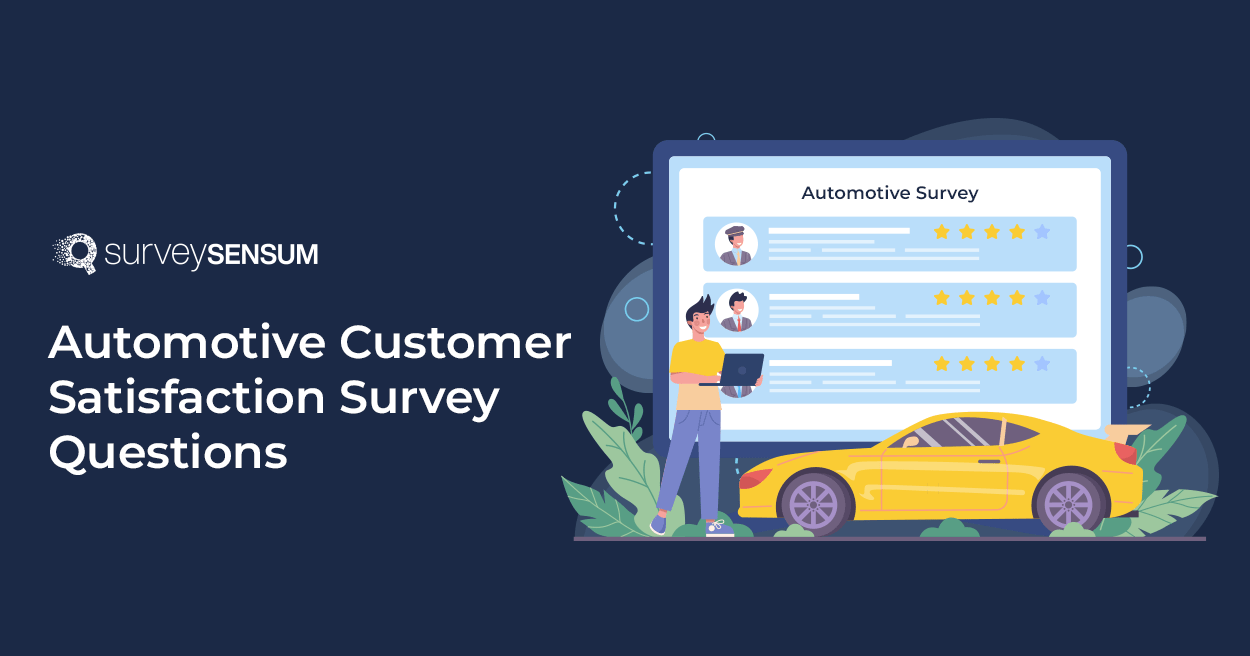
Sarah, a dedicated automotive repair shop owner, was determined to take her business to the next level. She realized that along with top-notch service, it is also important to understand customers’ needs and satisfaction.
Sarah initiated a customer satisfaction survey to gather insights on automotive customers’ experiences. Crafting the survey, she carefully selected questions to capture the essence. Some questions she included were:
“On a scale from 1 to 10, how would you rate your overall experience with our automotive repair services?”
“Would you recommend our automotive repair shop to your friends and family?”
Armed with her well-crafted survey, Sarah distributed it to customers, and responses flooded in.
Using an efficient automotive feedback tool, she found that most customers rated their experience a 9 or 10, but some noted communication issues during repairs. Sarah then took the CSAT score into account, and improved the repair process, emphasizing clarity. As a result, her shop not only retained loyal customers but also gained new ones through positive referrals.
Sarah’s story highlights the importance of never underestimating the power of asking the right questions. And just like Sarah, you too can elevate your automotive business by understanding and acting on your customers’ feedback using CSAT tools. And for that, we have provided 20+ automotive customer satisfaction survey questions that you can ask in the next survey.
20+ Must-Ask Automotive Customer Satisfaction Survey Questions
1. Intender (Pre-Sales) Survey
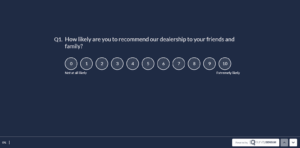
The main goal of the Intender (Pre-Sales) automotive customer satisfaction survey is to systematically gather feedback and insights from potential car buyers during the pre-sales phase of their journey.
This survey will help you understand the following five important touchpoints of your automotive customer journey.
So, here are a few important questions you can ask in the different stages of the pre-sales journey.
Overall Satisfaction
- How satisfied are you with your pre-sales experience with our dealership?
- How likely are you to recommend our dealership to your friends and family?
Customer Profile
- What is your age?
- What is your income?
- What is your occupation?
- What is your education level?
- What are your needs and wants when it comes to a car?
- What are your biggest concerns when buying a car?
- What websites, social media platforms, or other resources did you use to research cars and dealerships before you visited us?
Car Models and Dealers
- Which car models are you most interested in?
- Which dealerships have you visited?
- What was your experience like at the other dealerships?
Sales Process Satisfaction
- How satisfied are you with the sales process at our dealership?
- Did the salesperson explain the features of the car clearly?
- Did the salesperson provide an accurate delivery date?
- Did the salesperson explain the financing options clearly?
Social Media Influencers
- Have you made purchase decisions based on recommendations from social media influencers?
- Which social media influencers do you follow before visiting the dealer?
- Which social media platforms do you primarily use for gathering information about cars and dealerships?
Things to Understand from the Feedback
- Measuring customers’ likelihood to recommend your dealership reveals insights into organic growth via referrals.
- Creating customer profiles will help you in creating tailored offerings and communication strategies.
- Identifying the car models and dealerships that customers are considering provides a competitive edge.
- Addressing key issues like feature explanations, delivery time, and transparent finance builds trust and improves conversion rates.
- By analyzing which influencers or channels your potential customers follow, you can collaborate with relevant influencers that align with their interests.
The feedback gathered at various stages of the pre-sales process will help you enhance customer satisfaction, tailor your services, and make informed marketing and sales decisions.
But, what about the ones who rejected your dealership? Don’t they have some valuable insights to share? Let’s find out!
2. Rejector (Pre-Sales) Survey
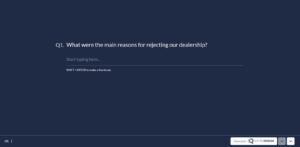
The primary objective of the Rejector Survey is to understand why potential customers chose not to purchase a vehicle from your dealership after engaging in the pre-sales process. This survey is conducted after dealers have marked sales as lost. Doing this survey can help understand the key reasons for rejection and improve on it.
So, let’s explore the key automotive customer satisfaction survey questions that you can ask at different stages.
Overall Satisfaction
- How satisfied are you with the pre-sales experience you received from our dealership?
- How likely are you to recommend our dealership to your friends and family?
Reasons for Rejecting
- What were the main reasons for rejecting our dealership?
- Which car models were you considering?
- Which dealerships did you visit?
- What was your experience like at the other dealerships?
Competition
- Which other dealerships did you consider?
- What specific benefit did you receive from the other dealership that you didn’t find with us?
These are the questions that you can in your next automotive customer satisfaction survey. But what are the benefits of asking these questions? Let’s see.
Things to Understand from the Feedback
- By analyzing the main reasons for rejection, you can pinpoint areas in your pre-sales process that require immediate attention.
- Knowing which specific car models are causing you to lose business to competitors helps in product positioning, pricing adjustments, and targeted marketing efforts.
- The survey highlights areas where potential customers believe you could improve.
- These comments can offer deeper insights into why deals were rejected and help sales and marketing teams make necessary improvements.
By understanding why potential customers chose not to buy from you and taking steps to rectify those issues, you will enhance your dealership’s competitiveness, increase sales, and conversion rates, and ultimately boost its success in the automotive market.
Launch Effective Automotive Pre-Sales Surveys With SurveySensum!
3. Product Quality Survey (Inbound & Outbound)
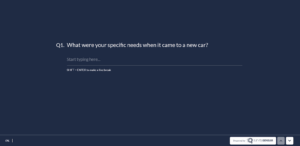
The primary goal of the Product Quality Survey is to gain a comprehensive understanding of the experiences and opinions of car buyers.
Such as – the buying process and profiling buyers by car model, reasons for their purchase decisions, assessing the alignment between expectations and experiences, and gathering feedback on the car’s features and quality.
Here are some potential questions that you can ask to gain insights into your customer’s satisfaction with your product quality:
Reason for purchase
- What were your main reasons for purchasing X car at this time?
- What were your specific needs when it came to a new car?
Expectation and Experience Gap
- What were your expectations for the car-buying process?
- How did your experience with our dealership meet your expectations?
- What areas of the car buying process could we have improved?
- What were your expectations for the car itself?
- How does the car meet your expectations?
- What areas of the car could we have improved?
Things they love and things they don’t
- What are the things you love most about your car?
- What are the things you don’t like about your car?
- Is there any functionality that you wish your car had?
- Is there any functionality that you find unnecessary?
Any Known Defects?
- Have you experienced any problems with your car?
- If so, what were the problems?
- How did we handle the problems?
Things to Understand From the Feedback
- Help you in identifying common interests that may influence customer’s choice of car model.
- This survey will identify the top reasons and motivations for your customers to buy a car in the first place.
- It will collect data on what customers expected and whether or not the expectations were met.
- Soliciting feedback on specific features or aspects of the car that customers particularly liked and disliked.
- Inquiring about any known defects or problems customers have encountered with their cars.
You have now gathered all this feedback but what what to do with it?
What To Do With the (Pre-Sales and Product Quality) Feedback?
Here’s how you can utilize the feedback you gathered from your automobile customer satisfaction survey.
- Create a Consolidated Report and Analyze the Data: This analysis helps in identifying patterns, trends, and areas that require attention, making it easier to pinpoint specific challenges and opportunities.
- Share with the Sales and Marketing Team: This ensures that the insights are disseminated to those responsible for making necessary improvements. They can tailor their strategies based on feedback.
- Identify Major and Minor Challenges: Categorizing challenges allows for the prioritization of action plans. Major challenges will require immediate attention, while minor ones can be addressed as resources and time permit.
- Train Sales and Marketing Teams: Training is crucial for ensuring that sales and marketing teams understand the feedback and know how to apply it in their roles.
- Monitor Progress on Actions Taken: Tracking progress through quarterly or half-yearly trends allows you to assess the effectiveness of the actions taken. It provides an opportunity to make adjustments to action plans if necessary.
Pro tip: Use tools like Text Analytics to identify emerging complaints, track customer sentiment, and act in real time.
By following these steps, your dealership demonstrates a commitment to actively listening to customers and taking action to meet their needs and expectations. This customer-centric approach can lead to improved customer loyalty, positive word-of-mouth referrals, and long-term success in the competitive automotive industry.
Create Effective Product Quality Surveys with SurveySensum!
Now, that we understand the importance of sending the right automotive customer satisfaction survey questions to understand the pre-sales journey and the quality of the product, let’s now explore the importance of understanding the QVOC in your sales and after-sales service.
1. QVOC Sales Survey
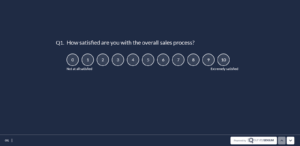
The primary goal of the QVOC Sales Survey is to ensure a smooth and satisfactory onboarding experience for customers at your dealership. This survey focuses on gathering feedback related to the sales process, delivery experience, and dealership treatment to identify areas of improvement and enhance the overall customer experience.
Why Ask?
With this survey, your dealership can gain valuable insights into customer satisfaction, expectations, and areas that require attention.
Here are some effective automotive customer satisfaction survey questions that you can ask to assess your sales process.
Overall Satisfaction
- How satisfied are you with the overall sales process?
- How satisfied are you with the delivery experience?
- How likely are you to recommend our dealership to your friends and family?
Customer Expectations
- Were your finances cleared on time?
- Were you able to take your car for a first ride before delivery?
- Was your car free of any defects at delivery?
- Did you understand all of the features of your car?
- Was your car delivered at the promised time?
Dealer Treatment
- How did the dealer treat you during and before delivery?
- Did the dealer communicate with you regularly during the waiting period?
- Were there any financial surprises during the delivery process?
- Did the dealer clearly explain the features of your car?
- Did the dealer provide you with all of the necessary information like insurance, warranty, and after-sales documentation?
Satisfaction With the Buying Process
- How satisfied are you with the overall car-buying experience at our dealership?
- How do you feel about your purchase experience and delivery?
- Issues and resolution
- Were there any issues encountered during the delivery process?
- If so, how were the issues resolved?
- Do you know who to contact if you have any questions about your car?
Issues and Resolution
- Were there any issues encountered during the sales or delivery process?
- If so, how were the issues resolved?
- Do you know who to contact if you have any questions or concerns about your car?
Things to Understand QVOC Survey – Sales
- Analyzing NPS by dealer, city, region, and national level allows for pinpointing areas of excellence and opportunities for improvement.
- Monitoring whether cars are delivered as promised helps in improving logistics and managing customer expectations.
- Understanding how customers perceive their treatment by the dealer during and before delivery helps in training and improving dealer-customer interactions.
- These questions provide insights into the customers’ journey and sentiment regarding their purchase experience.
By collecting and analyzing feedback through this survey, your dealership can continually enhance the automotive customer experience, strengthen customer relationships, and foster customer loyalty, ultimately driving long-term success in the automotive industry.
2. QVOC Service Survey (After Sales Satisfaction)
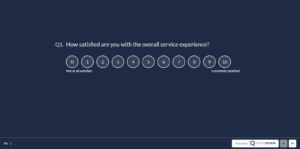
The primary goal of the QVOC Service Survey is to ensure that customers’ post-purchase service experiences are exceptional, leading to their satisfaction and loyalty.
When to Ask?
The survey should be conducted immediately after service, and follow-ups should be initiated if customers do not respond initially.
Why Ask?
The survey aims to understand how customers feel after servicing their cars at your dealership. It assesses service delays, issue resolution, and areas for improvement to encourage customers to return.
This CSAT survey design helps you assess various aspects of the service process, from customer expectations and service quality to the waiting area experience and repeat service. Let’s explore the key questions and significance of this survey:
Overall Satisfaction
- How satisfied are you with the overall service experience?
- How likely are you to recommend our service department to your friends and family
Customer Expectations
- Were your concerns and issues addressed to your satisfaction?
- Did the service department provide you with a transparent pricing estimate?
- Was your car delivered on time and in good condition?
- Were parts available if needed?
Service Quality
- Did the service department inspect your car thoroughly?
- Were all of the repair works performed correctly?
- Did the service department keep you updated on the progress of the repairs?
- Did the service department explain the repair work in a clear and concise way?
Waiting Area
- Was the waiting area clean and comfortable?
- Were there snacks, coffee, and other refreshments available?
- Was there Wi-Fi available?
Repeat Customers and Revenue
- How many times have you had your car serviced at our dealership?
- What is the average amount of money you spend on each service visit?
Satisfaction and Repeat Service
- How satisfied are you with the overall service experience at our dealership?
- How likely are you to return to our dealership for future service visits?
Now, that we know which important CSAT questions to ask in this survey, let’s understand when and why to ask for this feedback and what to do with it.
What To Do With the Feedback?
- Close the feedback loop by analyzing the feedback and sharing it with the respective dealers and after-sales teams.
- Consolidate data and perform analysis by dealership, region, car model, and service workshop. Closing the loop is essential to track progress and improve service quality.
By actively collecting, analyzing, and acting upon feedback from the QVOC Service Survey, your dealership can continuously improve service quality, enhance customer satisfaction, and cultivate customer loyalty, resulting in long-term success in the automotive service industry.
→ Read more about the strategic impact of the journey-based csat survey!
Utilize and enhance the impact of all these surveys in your customer experience. Create effective surveys at key touchpoints today with SurveySensum!
How to Improve Customer Satisfaction in the Automotive Industry?
After measuring customer satisfaction, it is imperative to work towards improving it and this involves several key strategies:
- Prioritize the Customer: This means putting the customer’s needs and preferences first. Instead of focusing solely on selling products, the emphasis should be on providing solutions that meet the customer’s requirements. This approach involves understanding the customer’s situation, listening to their concerns, and offering personalized recommendations.
- Never Mislead: Honesty is crucial in building long-term trust with customers and making your customer satisfaction strategy effective. Even if it means not closing a sale immediately, providing accurate information and setting realistic expectations will earn credibility and respect. Misleading customers can lead to negative word-of-mouth and damage the reputation of the business.
- Build Trust: Utilize various methods to establish trust with customers. This includes showcasing positive testimonials and reviews from satisfied customers, maintaining transparent communication about products and services, and demonstrating reliability and consistency in interactions.
- Professional Multi-Channel Marketing: Ensure that your online presence across different channels (such as website, social media, email, etc.) is professional, engaging, and customer-centric. Use these platforms to connect with customers, share valuable content, and provide easy access to information and support.
- Upgrade Digital Channels: Leverage technology and tools like Video for Sales to enhance the digital experience for customers. Video content can be used to showcase products, provide virtual tours, explain features and benefits, and engage customers in a more interactive and personalized way.
- Streamline Processes: Simplify and optimize the customer journey by reducing complexity and friction points. This includes making it easy for customers to find information, navigate through your website or showroom, complete transactions efficiently, and receive prompt assistance and follow-ups.
By implementing these customer satisfaction best practices and strategies cohesively, automotive businesses can adopt a customer-centric approach that not only enhances satisfaction but also fosters loyalty, repeat business, and positive referrals.
→ Know more about how to improve automotive customer satisfaction!
Conclusion
Using automotive customer satisfaction survey data effectively is crucial for improving your business and achieving long-term success in the competitive automotive industry.
Incorporating these automotive customer satisfaction survey questions into your automotive business will not only lead to higher customer satisfaction but also foster customer loyalty and advocacy. Over time, this can translate into increased revenue, positive brand reputation, and sustained success in the automotive industry.
Remember that for consistent gathering, analyzing, and acting on customer feedback you need an effective CSAT tool like SurveySensum that will allow you to track analyze, and resolve complaints in real-time – closing the feedback loop.
FAQs
Improve customer satisfaction in the automotive industry by using car survey questions and enhancing product quality, providing excellent customer service, offering personalized experiences, leveraging technology for convenience (like online booking and service tracking), and actively listening to customer feedback to address concerns.
Knowing customer experience in the automotive industry encompasses a car dealership customer satisfaction survey of every interaction a customer has with a car company, from purchasing and servicing a vehicle to post-purchase support. It includes aspects like product quality, dealership experience, after-sales service, and overall satisfaction with the brand.
Customer loyalty in the automotive industry refers to customers’ likelihood to repurchase vehicles from the same brand or dealership, recommend the brand to others, and maintain a long-term relationship with the company based on positive experiences, trust, and satisfaction. Do this by conducting customer satisfaction surveys for dealers and customers alike.
Good customer satisfaction survey questions typically focus on:
- Overall satisfaction with the product/service.
- Likelihood to recommend to others.
- Specific aspects like ease of use, quality, and customer support.
- Areas for improvement or suggestions.
- Demographic questions for segmentation and analysis.
The four types of car dealership survey examples are:
- Transactional Surveys: Sent after specific interactions, like a purchase or customer support call.
- Periodic/Relationship Surveys: Sent at regular intervals to measure overall satisfaction and loyalty.
- Post-Experience Surveys: Sent after a particular event or experience, such as a service visit or webinar.
- On-Demand/Ad Hoc Surveys: Initiated based on specific triggers or customer actions, like a canceled subscription or product return.
You can ask for a customer satisfaction survey by:
- Sending a direct email or SMS after the customer interaction.
- Including a survey link on receipts, invoices, or order confirmations.
- Using in-app pop-ups or prompts on your website.
- Mentioning the survey during customer service calls or chats.
- Utilizing social media platforms or newsletters to reach out to customers.
The top automotive CSAT tools are SurveySensum, Qualtrics, and Zonka Feedback, among others. You can use these to gather valuable feedback from your customers.






